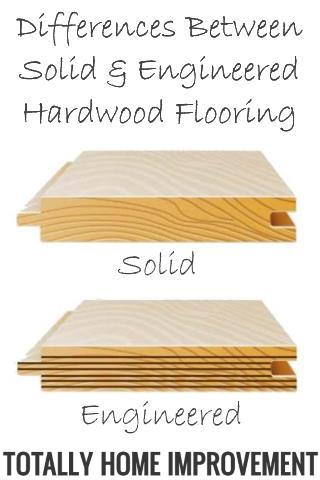
Hardwood flooring looks great - in fact it's my favorite flooring surface. To my way of thinking wood floors look and feel warmer than tiles (although they have their place in the bathroom and kitchen) and wood is certainly easier to maintain than carpet.
But when it comes to choosing a genuine wood flooring material (note that I'm not including laminate which is a synthetic product), you have two choices - you can go with Solid Hardwood or Engineered Hardwood. In this article I'll outline the differences between these two types of wood flooring.
Environmental Impact
I'm starting with environmental considerations because they are all-too-often overlooked when discussing wood products. There are two main ways in which your choice of flooring will have different levels on impact on the environment:
1. The production process
Solid hardwood is entirely comprised of hardwood while the engineered variety uses less hardwood by utilizing softwoods for the inner layers with a layer of hardwood only on the outside layers. Hardwoods take a lot longer to grow than softwoods so using engineered wood is better for the environment.
Another important difference in the production process is that hardwood planks have to be cut with a saw whereas engineered woods are sliced producing no sawdust. My father worked in the forestry industry when I was a child and I spent a bit of time hanging around sawmills - I can tell you that all that sawdust from milling really adds up quite quickly. Although sawdust can be reused, most of the purposes it's used for result in it's carbon content being fairly quickly released back into the atmosphere.
2. The supplier's environmental programs
Some companies that produce wood products take their environmental credentials quite seriously. For example Hardwood Bargains have a replanting program, which they conduct in conjunction with American Forrests, where they plant 2 trees for every 1 tree used in producing their flooring products.
Before you decide on a supplier, I recommend you ask them what they are doing to ensure the sustainability of wood production and our forests into the future.
Cost
Solid hardwood when compared with the same engineered wood species is generally more expensive to buy upfront.
Engineered woods are also generally easier to install as a DIY project meaning you can save on the installation process. This is partly because solid hardwood requires a plywood sub-floor whereas you can put engineered wood on almost any reasonably flat surface including concrete.
Versatility
You can use engineered wood flooring below grade (IE in a basement) but it's strongly recommended that you don't that with solid hardwood because it's much more sensitive to moisture.
Having a radiant heat system installed below the floor is becoming ever more popular these days due to its high energy efficiency. Although it is possible to do this with a solid hardwood floor, it's a tricky business to get right because solid wood planks expand and contract as the amount of heat changes - this can lead to gaps opening up between the planks. On the other hand most engineered woods undergo very little expansion and therefore can be used quite readily with radiant heat systems - but always check with your supplier to ensure your product choice is suitable for this purpose if that's what you want to do.
Durability
Solid hardwood is tougher and will last longer. It also offers the advantage of being able to be sanded back and refinished multiple times, further extending the life of the floor.
Engineered wood on the other hand can usually only be sanded back twice at most before you have sanded off too much of the top solid layer. A couple who are friends of mine rented a house while their new house was being built and they let their rather large dog run around inside all over the hardwood floor - the dog's claws left pit marks all over the floor. When it came time to move into their new home they called in a contractor to sand back and refinish the floors, as they had always planned to do, and discovered to their horror that it was an engineered wood floor and it had to be ripped up and completely replaced.
My Conclusion
Although a solid hardwood floor is likely to outlast an engineered hardwood floor, I really like the versatility of the engineered option and I much prefer the lessened environmental footprint it has.
As always there's a certain amount of personal taste involved, so which ever way you choose to go enjoy your new hardwood floor!
You might also like to read:
• Budget Flooring Ideas
• Oak vs Pine for Furniture
• How To Store Timber
• How Wood Rots and How to Prevent It
Category:




